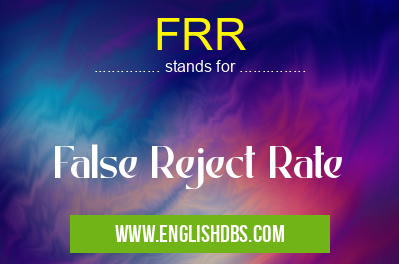What does FRR mean in UNCLASSIFIED
False Reject Rate (FRR) is a critical metric in biometrics, security systems, and authentication mechanisms. It measures the percentage of authorized individuals who are incorrectly rejected or denied access due to a system's inability to recognize them. Understanding FRR is crucial for designing and deploying effective and user-friendly security measures.

FRR meaning in Unclassified in Miscellaneous
FRR mostly used in an acronym Unclassified in Category Miscellaneous that means False Reject Rate
Shorthand: FRR,
Full Form: False Reject Rate
For more information of "False Reject Rate", see the section below.
What does FRR Mean?
FRR is calculated as the number of false rejections divided by the total number of authorized individuals who attempted access. A high FRR indicates that the system is frequently denying access to legitimate users, creating inconvenience and potentially compromising security.
Factors Affecting FRR
- Biometric Sensor Quality: The accuracy of the biometric sensors used to capture data can significantly impact FRR. Poor-quality sensors may fail to capture sufficient data or produce noisy signals, leading to incorrect rejections.
- Algorithm Performance: The algorithms used to compare captured data with stored templates play a vital role in determining FRR. Sophisticated algorithms that can handle variations in biometric data over time can reduce false rejections.
- Environmental Conditions: Factors such as lighting conditions, temperature, or humidity can affect the quality of biometric data captured. Unfavorable environmental conditions can increase FRR.
- User Behavior: Improper use of biometric systems, such as incorrect placement of fingers on scanners or failure to follow instructions, can contribute to false rejections.
Reducing FRR
Minimizing FRR is essential for practical and effective security systems. Strategies to reduce FRR include:
- Using high-quality biometric sensors
- Implementing robust algorithms
- Ensuring optimal environmental conditions
- Providing clear instructions to users
- Performing regular maintenance and calibration
Essential Questions and Answers on False Reject Rate in "MISCELLANEOUS»UNFILED"
What is False Reject Rate (FRR)?
False Reject Rate (FRR) is a measure of a biometric system's ability to correctly reject unauthorized users. It represents the percentage of genuine users who are incorrectly rejected by the system. A low FRR indicates that the system is effective at preventing unauthorized access.
Final Words: FRR is a key metric that evaluates the effectiveness of biometric and security systems. By understanding the factors that affect FRR and implementing strategies to reduce it, organizations can enhance the accuracy and usability of their security measures. A low FRR ensures that authorized individuals are consistently recognized and granted access, while minimizing inconvenience and potential security breaches.
FRR also stands for: |
|
| All stands for FRR |
